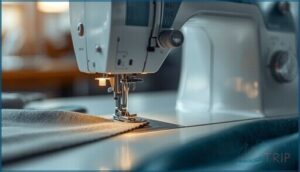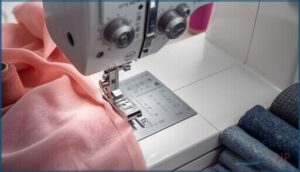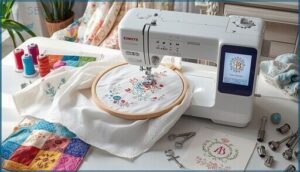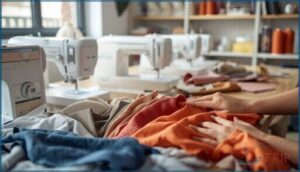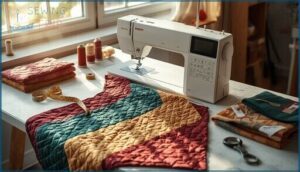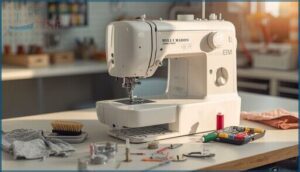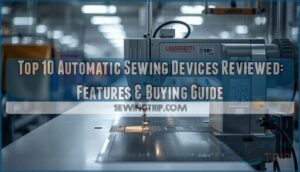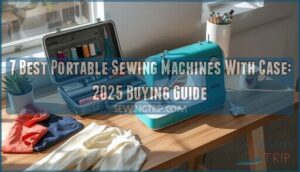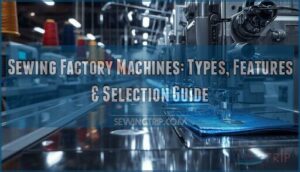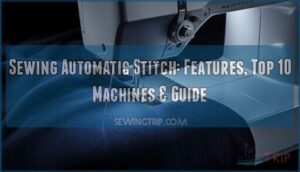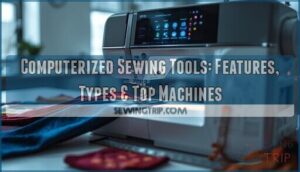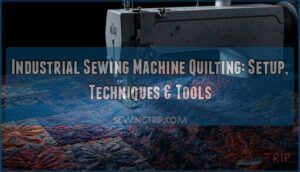This site is supported by our readers. We may earn a commission, at no cost to you, if you purchase through links.
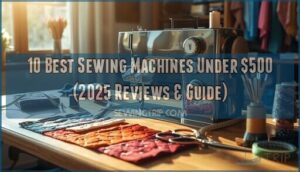
Many sewers assume they need to spend twice as much for machines that tackle everything from simple hemming to complex quilting. That’s not true anymore. Today’s budget-friendly models pack surprising capabilities, from automatic needle threaders to dozens of built-in stitches.
The challenge isn’t finding options—it’s knowing which features matter for your specific projects and which ones are just marketing fluff dressed up as essentials.
Table Of Contents
- Key Takeaways
- Factors to Consider Before Buying
- Key Features in Budget Sewing Machines
- Best Sewing Machines Under $500
- 1. Brother XM2701 Sewing Machine Lightweight
- 2. Brother XR3774 Sewing Quilting Machine
- 3. SINGER 4411 Heavy Duty Sewing Machine
- 4. SINGER Tradition 2277 Sewing Machine
- 5. Brother GX37 Sewing Machine for Beginners
- 6. SINGER 4432 Heavy Duty Sewing Machine
- 7. Brother ST371HD Strong Sewing Machine
- 8. Juki HZL 70HW Sewing Machine
- 9. Brother CS7000X Sewing Quilting Machine
- 10. Heureux Computerized Sewing and Quilting Machine
- Choosing The Right Machine for Projects
- Quilting Machine Essentials on a Budget
- Maintenance Tips and Must-Have Accessories
- Frequently Asked Questions (FAQs)
- Conclusion
Key Takeaways
- Quality sewing machines under $500 now include professional features like automatic needle threaders, metal frames, and dozens of built-in stitches, making them capable of handling everything from basic repairs to quilting without requiring a bigger budget.
- Matching your machine to your actual fabric types and project needs matters more than chasing the highest stitch count—beginners should prioritize ease of use and reliability while experienced sewers can focus on specialized features like throat space for quilting or motor strength for heavy fabrics.
- Heavy-duty models like the Singer 4411 and 4432 can power through thick materials like denim and canvas at 1,100 stitches per minute, proving that budget machines can deliver serious performance when built with metal frames and strong motors.
- Regular maintenance like cleaning lint buildup every few projects, using quality needles matched to your fabric, and proper oiling will extend your machine’s life and prevent common problems like thread bunching, skipped stitches, and tension issues.
Factors to Consider Before Buying
Before you invest in a new sewing machine, you’ll want to think through a few key factors that can make or break your sewing experience. The right choice depends on what you’re actually planning to create, how often you’ll use it, and what features matter most for your skill level.
Let’s look at the main considerations that’ll help you pick a machine that fits your needs and budget.
Purpose and Intended Use
Before you spend a single dollar, think about what you’ll actually be sewing—casual mending projects need a totally different machine than someone planning to tackle quilts or garment construction every weekend.
Your skill level and sewing frequency matter too. An all-purpose sewing machine for beginners treats lighter fabrics differently than one built for heavy-duty use.
Match your project complexity and intended lifespan to features in any sewing machine under 500 you’re considering.
Mechanical Vs. Computerized Models
Choosing between mechanical and computerized models often comes down to three factors:
- Ease of Use: Mechanical sewing machines use dials and levers, while computerized sewing machines offer digital displays and push-button controls.
- Repair Costs: Mechanical models have simpler parts that cost less to fix, whereas computerized versions may need expensive electronic repairs.
- Feature Complexity: Computerized machines pack more Sewing Machine Features into a Sewing Machine Under 500, but mechanical versions deliver reliable Stitch Precision without the learning curve. For beginners, mechanical machines are often easier to learn on.
Your Sewing Machine Buying Guide should weigh Power Consumption and long-term value against immediate convenience.
Stitch Patterns and Versatility
Once you’ve settled on mechanical or computerized, the number and type of stitches your machine offers will shape what you can actually create. Most Best Sewing Machines under $500 include 20 to 100 Stitch Patterns and Quality options. Here’s what matters:
| Stitch Type | Best For |
|---|---|
| Decorative Stitches | Embellishing garments and home décor |
| Buttonholes | Professional finishing on shirts and jackets |
| Stretch Stitches | Knits, activewear, and flexible fabrics |
| Heirloom Stitches | Vintage-style projects and Monogramming |
Check Sewing Machine Reviews to confirm your All-Purpose Sewing Machines can manage the techniques you’ll use most—your Sewing Machine Buying Guide depends on it.
Stitch Quality and Speed
Having plenty of stitches is great, but how those stitches actually turn out—and how quickly you can sew them—will determine whether your projects look polished or homemade.
Look for machines with strong motor power and consistent fabric feed to maintain stitch quality at higher speed settings.
The best affordable sewing machines under $500 balance speed with vibration control, so you’re not wrestling a bouncing machine when you switch gears.
Machine Design and Portability
If you’re hauling your machine between a sewing room, dining table, and weekend workshops, weight and footprint matter just as much as what’s under the hood. Lightweight models around 12-15 pounds make moving easier, and compact storage dimensions help when space is tight.
Look for ergonomic design with built-in grips or available carry cases. Frame materials like metal still offer stability without excessive bulk, so your portable sewing machine doesn’t sacrifice performance for convenience.
Build Quality and Durability
A machine that falls apart after a few months won’t matter how many fancy stitches it promised on the box. Look for these durability markers to secure long-term value:
- Metal frame construction – Provides vibration reduction and stitch consistency under heavy use
- Motor strength ratings – Determines how well heavy-duty sewing machines manage thick fabrics
- Component lifespan warranties – Signal manufacturer confidence in durable sewing machines
Frame materials and build quality directly impact your machine’s staying power.
Key Features in Budget Sewing Machines
When you’re shopping for a sewing machine under $500, you don’t have to settle for bare-bones basics. Today’s budget-friendly machines pack in features that used to cost hundreds more, making it easier than ever to find a model that fits your needs.
Here’s what to look for when comparing your options.
Automatic Needle Threader and Tension Control
Threading needles by hand and fiddling with tension dials can turn a quick sewing session into a frustrating test of patience, but modern budget machines now take care of both tasks for you. Automatic needle threaders guide your thread through the eye in seconds, while built-in tension adjustments prevent thread breakage and puckered seams. These sewing machine features save time and reduce errors.
| Feature | Manual Process | Automated Process |
|---|---|---|
| Threading Mechanisms | 2-3 minutes, strain on eyes | 5-10 seconds, push-button ease |
| Tension Adjustments | Trial and error, frequent fixes | Auto-sensors detect fabric weight |
| User Experience | Frustration, learning curve | Immediate results, confidence boost |
| Thread Breakage | Common with wrong settings | Rare, system self-corrects |
Automation benefits make sewing machines under 500 accessible for beginners while keeping experienced sewers productive.
Adjustable Stitch Length and Width
You can’t sew a delicate hem with the same stitch you use for upholstery seams, and that’s where adjustable stitch length and width become your creative control panel. Longer stitches speed through seams, while shorter ones anchor buttonholes.
Adjustable stitch length controls fabric feed, and stitch width expands decorative stitch options. Refined adjustments let you fine-tune every project, making sewing machines under 500 surprisingly adaptable for different fabrics and techniques.
Free Arm and Extension Table
Cuffs, collars, and sleeves turn into a wrestling match without a free arm, which slides around tubular fabric like a glove on a hand. An extension table gives you a wide workspace for quilts and larger projects, turning any sewing machine under 500 into a mini workstation.
- Free arm lets you navigate tight spaces on children’s clothing
- Wide table stabilizes yards of fabric during long seams
- Project compatibility shifts from hemming pants to piecing quilts
- Storage considerations matter since detachable tables save counter space
Drop-in Bobbin System
Drop-in bobbins clear the loading-from-the-front headache, showing you exactly how much thread remains through a see-through window. This visibility advantage prevents mid-seam surprises and cuts jamming issues that plague traditional bobbin threading ease. Regular maintenance needs stay minimal since dust collection spots are easy to reach in any sewing machine under 500.
| Feature | Why It Matters |
|---|---|
| Clear window view | Spot low thread before stitches falter |
| Top-loading design | No side-panel fumbling during quick changes |
| Standard bobbin size | Replacement compatibility across brands |
| Snap-in mechanism | Alignment happens without guesswork |
Built-in Embroidery and Quilting Functions
Built-in embroidery and quilting functions transform standard stitching into creative expression without stretching your budget. Machines under $500 generally pack 70 to 135 embroidery designs plus 6 to 9 font styles for monogramming, while quilting models deliver 80 to 197 builtin stitches for piecing and topstitching.
Workspace dimensions matter—most embroidery fields measure 4″ x 4″, and quilting projects benefit from 6 to 8 inches of throat space. Speed regulation ranges from 650 stitches per minute for embroidery to 1,500 for quilting applications.
Customization options let you resize, rotate, and upload designs via USB, while included quilting feet facilitate walking, darning, and free-motion techniques. Quilting’s origins are ancient, with quilting history traced back thousands of years.
Accessory Compatibility
Before you add presser feet or specialty attachments to your cart, confirm that your machine accepts universal accessories or requires brand-specific parts. Budget-friendly machines commonly include 6 sewing feet and accept standard low-shank presser feet, Class 15 bobbins, and household needle types (sizes 11 to 16).
- Universal presser feet fit most low-shank machines, expanding your options for zippers, buttonholes, and blind hems without breaking the bank.
- Extension tables create extra workspace for quilting accessories and large projects, though you’ll want to verify mounting compatibility.
- Thread spools and bobbins vary by brand—stock up on compatible sizes to avoid mid-project frustration.
Best Sewing Machines Under $500
You’ve got plenty of solid options when shopping for a sewing machine under $500. The models below offer a range of features, from lightweight portability to heavy-duty power, so you can find one that matches your sewing style.
Here’s a closer look at ten machines that deliver real value without breaking the bank.
1. Brother XM2701 Sewing Machine Lightweight
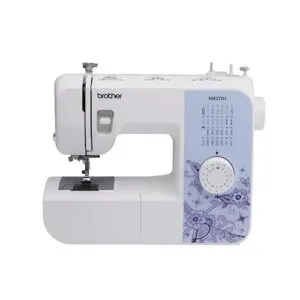
Affordability meets function with the Brother XM2701, a sewing machine that’s easy to carry and simple to operate. This lightweight design weighs just under 13 pounds, making it perfect if you’re short on space or need to move your machine around.
With 27 built-in stitches covering everything from utility to decorative work, you’ll find stitch adaptability that addresses most home sewing projects. The automatic needle threader and drop-in bobbin system make it genuinely beginner friendly, cutting down setup frustration.
Keep in mind this machine needs regular maintenance to prevent jamming, especially when working with lint-heavy fabrics. Project suitability leans toward lighter materials—think cotton, knits, and medium-weight fabrics—rather than multiple denim layers or leather.
Best For: Beginners and casual sewers who need a portable, budget-friendly machine for light to medium-weight fabric projects around the home.
- Lightweight at 12.6 pounds with compact dimensions, making it easy to store and transport between projects
- 27 built-in stitches with automatic needle threader and one-step buttonhole function simplify common sewing tasks
- 25-year limited warranty backed by lifetime technical support provides long-term value and peace of mind
- Struggles with heavyweight materials like multiple layers of denim or leather, limiting project scope
- Requires regular cleaning and maintenance to prevent jamming, especially when sewing lint-prone fabrics
- May produce thumping noise when working through thicker layers, which can be disruptive during use
2. Brother XR3774 Sewing Quilting Machine
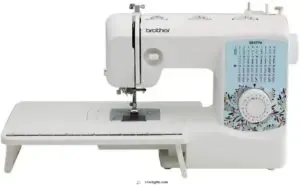
Moving past basic portability, the Brother XR3774 stands out with 37 built-in stitches and stronger quilting features than most budget machines. This sewing machine offers an automatic needle threader, one-step buttonhole, and a wide table that creates workspace for larger projects.
User friendliness shines through the drop-in bobbin and LED lighting, though common issues include occasional bobbin placement confusion and tension adjustments on different fabrics.
Build quality benefits from metal construction parts and a 25-year warranty. At 12.3 pounds, it balances portability with the durability needed for regular quilting work.
Stitch range covers decorative, blind hem, and quilting stitches effectively.
Best For: Beginners and intermediate sewers who want a reliable machine for everyday sewing and quilting projects without breaking the bank.
- 37 built-in stitches with automatic needle threader and one-step buttonhole make setup quick and versatile
- Wide table and included quilting feet (walking foot, quilting foot) provide solid workspace for larger projects
- Metal construction with 25-year warranty offers durability at a budget-friendly price point
- Bobbin placement can be tricky and cause stitch quality issues if not inserted correctly
- Tension requires frequent adjustment when switching between different fabrics
- Limited throat space and non-dropping feed dogs restrict advanced free-motion quilting capabilities
3. SINGER 4411 Heavy Duty Sewing Machine
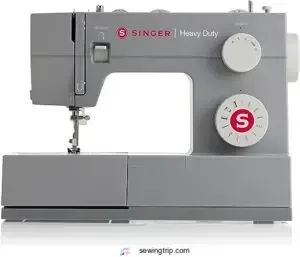
Thick fabric projects demand a machine that won’t quit mid-seam. The Singer Heavy Duty 4411 delivers with a metal frame, 1,100 stitches per minute, and the muscle to power through denim, canvas, and light leather.
You get 11 built-in stitches, adjustable stitch length up to 5mm, and a top drop-in bobbin system that simplifies threading. At 14.5 pounds, this heavy-duty sewing machine balances portability with serious build quality.
Four presser feet come included, and the LED workspace lighting helps you nail precise seams. Affordable sewing machines don’t usually manage heavy-duty performance this well, making it a standout in best sewing machines under $500.
Best For: Sewers tackling heavy fabrics like denim, canvas, and leather who need speed and durability without breaking the bank.
- Metal frame construction and 1,100 stitches per minute handle thick materials and layers without skipping stitches
- Simple top drop-in bobbin system and LED lighting make setup and precision sewing easier for beginners and experienced users
- Includes four presser feet and adjustable stitch settings (up to 5mm length, 6mm width) for versatile projects at an affordable price
- Some users report bobbin thread issues and occasional manufacturing defects that require customer service intervention
- Only works with 110-volt systems, limiting international use without a converter
- Best suited for home projects rather than commercial or industrial-grade sewing despite the “heavy duty” label
4. SINGER Tradition 2277 Sewing Machine
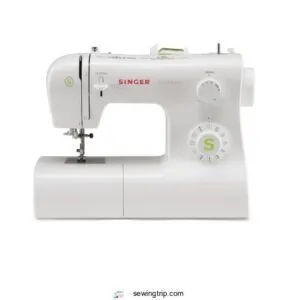
For all-around adaptability without breaking the bank, the Singer Tradition 2277 packs 23 built-in stitches and 97 stitch applications into a beginner-friendly package. You’ll find an automatic needle threader, adjustable stitch length and width, and a one-step buttonhole function that simplifies garment work.
The heavy-duty metal frame ensures stability, while the free arm design lets you tackle sleeves and cuffs with ease. This affordable sewing machine accommodates fabrics from sheer to denim, comes with multiple presser feet, bobbins, and a 25-year limited warranty—making it one of the best sewing machines under $500 for beginners and budget-conscious sewists.
Best For: Beginners and budget-conscious sewists who need a reliable, versatile machine for everyday projects like garments, home décor, and basic alterations.
- 23 built-in stitches and automatic needle threader make it easy to start sewing right away, even if you’ve never touched a machine before
- Heavy-duty metal frame keeps the machine stable during use, and the 25-year warranty backs up the quality construction
- Comes with multiple presser feet, bobbins, and accessories so you can tackle buttonholes, zippers, and various fabric types without buying extras
- Reverse stitch lever placement feels awkward and may get sticky with heavy use
- Lightweight design means the machine can shift around during fast sewing or when working with thick fabrics
- Limited to basic stitches, so advanced sewists looking for complex decorative options will outgrow it quickly
5. Brother GX37 Sewing Machine for Beginners
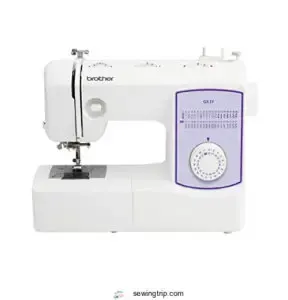
When you’re just getting started, the Brother GX37 sewing machine for beginners offers 37 built-in stitches and an automatic needle threader that takes the frustration out of setup. Its compact, portable design is perfect for beginner sewists who need an affordable product they can move around easily.
You’ll appreciate the drop-in bobbin, free arm for sleeves, and six included feet (zigzag, zipper, buttonhole, and more)—making this one of the most adaptable sewing machines in its price range.
Keep in mind the fabric limitations: thick layers like multiple canvas pieces can slow it down, but for everyday garment repairs, quilting, and home decor, it delivers solid stitch variety and beginner friendliness.
Best For: New sewers who want an easy-to-use machine with plenty of stitch options and automated features that make threading and setup less frustrating.
- Automatic needle threader and drop-in bobbin eliminate the most tedious parts of setup, so you can start sewing faster without wrestling with thread.
- 37 built-in stitches and six included feet give you enough variety to handle garment repairs, quilting, buttonholes, and home decor projects right out of the box.
- Compact and portable design makes it easy to move between rooms or store away when you’re not using it.
- Struggles with thick or layered fabrics like multiple pieces of canvas, so it’s not ideal for heavy-duty projects or upholstery work.
- LED work light can be dim in low-light conditions, which might make detailed stitching harder to see.
- Changing the needle requires a screwdriver instead of a quick-release system, adding an extra step to maintenance.
6. SINGER 4432 Heavy Duty Sewing Machine
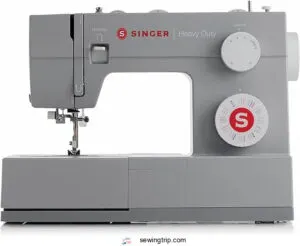
For heavy-duty performance that conquers denim and canvas without breaking a sweat, the SINGER Heavy Duty 4432 delivers 1,100 stitches per minute and 32 built-in stitches for under $300. This affordable product includes a metal frame for stability, automatic needle threader, and drop-in bobbin—usability features that make setup quick and frustration-free.
With a 25-year warranty coverage on the machine head, you’re getting serious longevity.
Sewing machine reviews highlight its speed and reliability, earning it a 4.3-star rating from owners who praise its stitch adaptability and ability to process both lightweight and heavyweight fabrics. Consumer reception confirms it’s a solid choice among heavy-duty sewing machines for home projects.
Best For: Sewers who need a reliable, fast machine that handles heavy fabrics like denim and canvas without spending over $500.
- Sews at 1,100 stitches per minute with a sturdy metal frame that stays stable during high-speed projects
- 32 built-in stitches and 110 applications give you flexibility for everything from basic hemming to decorative work
- 25-year warranty on the machine head shows SINGER backs the durability of this model
- Some users report build quality issues, including needle breakage and bobbin feed problems
- Speed control can be inconsistent, with sudden jumps that make precision work tricky
- Machine may struggle with certain fabrics and can be noisier than expected during operation
7. Brother ST371HD Strong Sewing Machine
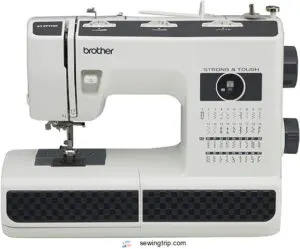
Conquering heavy-duty fabrics like denim, canvas, and gabardine becomes simple with the Brother ST371HD, one of the best sewing machines for sewers who refuse to compromise on power. This affordable product features 37 built-in stitches, an automatic needle threader, and a metal needle plate for smooth fabric feeding—proving that beginner friendliness and machine durability can coexist.
Sewing machine reviews praise its stitch range and 800-stitches-per-minute speed, while the user experience stays simple thanks to its jam-resistant bobbin system.
With a 25-year warranty, the Brother ST371HD stands firm among heavy-duty sewing machines that deliver long-term value.
Best For: Sewers tackling heavy fabrics like denim and canvas who need a durable, beginner-friendly machine without breaking the bank.
- Handles thick materials effortlessly with 37 built-in stitches and a metal needle plate that feeds fabric smoothly, even at 800 stitches per minute.
- Automatic needle threader and jam-resistant bobbin system make setup quick and frustration-free, perfect if you’re just starting out.
- 25-year warranty backs up the machine’s durability, so you’re covered for the long haul.
- Some users struggle with threading despite the automatic needle threader, which can slow down your workflow.
- Pedal may emit a burning plastic smell after extended use, raising durability concerns.
- Bobbins aren’t interchangeable with other Brother models, so you’ll need to stock up on the specific type.
8. Juki HZL 70HW Sewing Machine
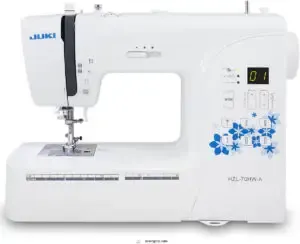
When you’re hunting for affordable products that pack pro-level power, the Juki HZL-70HW emerges as a standout sewing machine that challenges expectations. HZL-70HW Features include 80 built-in stitches and 5 automatic buttonholes, while Computerized Functions like LED display navigation and automatic needle threading simplify your workflow.
Weighing just 13 pounds with a hard case, its Portability Design suits sewers who crave mobility without sacrificing performance. Stitch Quality remains consistent across fabric types, thanks to adjustable presser foot pressure and speeds reaching 800 stitches per minute.
Though its Market Position hovers near $499-$599, Reviews frequently praise its reliability, placing it among the best sewing machines for users wanting elevated features in this price range.
Best For: Sewers wanting computerized features, excellent portability, and reliable stitch quality in a sub-$600 machine that handles everything from quilting to thick fabrics.
- 80 built-in stitches with LED display navigation and automatic needle threader make pattern selection and setup incredibly easy
- Weighs only 13 pounds with a hard case, perfect for classes, travel, or small workspace storage
- Adjustable presser foot pressure and 800-stitch-per-minute speed deliver consistent results across lightweight to heavy materials
- Some users report occasional jamming and tension issues that require adjustments
- Not built for heavy-duty or commercial-level frequent use despite solid performance
- Retail price pushes the upper edge of the sub-$500 range at most retailers
9. Brother CS7000X Sewing Quilting Machine
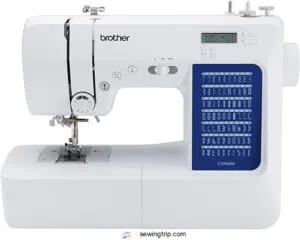
For sewers chasing Stitch Variety without the premium price tag, the Brother CS7000X delivers 70 built-in patterns spanning utility, decorative, and quilting functions—plus seven one-step buttonholes. Machine Durability stems from its metal frame and fixed needle bar, while User Friendliness shines through an improved automatic needle threader and jam-resistant drop-in bobbin.
You’ll appreciate the Included Accessories: 10 presser feet (including a walking foot), wide extension table, and hard case. Warranty Details cover 25 years on the machine body, making this Sewing Machine a savvy pick among affordable products for beginners and intermediate users alike.
Best For: Beginners and intermediate sewers who want versatile stitch options, quilting-friendly features, and solid build quality without spending over $300.
- 70 built-in stitches with 7 one-step buttonholes give you plenty of creative options for garments, quilts, and home décor projects.
- Metal frame and fixed needle bar deliver stable, reliable stitching that holds up over time, even on thicker fabrics.
- Generous accessory package includes 10 presser feet (like a walking foot), wide extension table, and hard case—everything you need to start quilting right away.
- Sewing speed maxes out at 750 stitches per minute, which is 100 spm slower than older Brother models like the CS6000i.
- Automatic bobbin threader can be tricky to master, and some users report frustration during initial setup.
- Only rated for 120 volts and US use, so you’ll need a step-down adapter abroad—and that might void your warranty.
10. Heureux Computerized Sewing and Quilting Machine
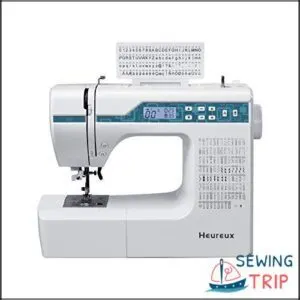
If Stitch Variety is your top priority, the Heureux Computerized Sewing Machine packs 200 built-in stitches—including 100 alphanumeric options—into a budget-friendly package under 14 pounds. Frame Durability comes from an aluminum alloy interior, while User Friendliness shines through the automatic needle threader and LCD display.
Portability Benefits make it easy to carry to workshops, and Quilting Performance manages multiple fabric layers smoothly. This beginner-friendly affordable device includes essential presser feet and video tutorials, though some users report foot pedal reliability concerns after extended use.
Best For: Budget-conscious beginners and intermediate sewers who want extensive stitch variety, portability, and computerized convenience without breaking the bank.
- 200 built-in stitches including 100 alphanumeric options give you creative flexibility for monogramming, quilting, and decorative projects at a fraction of what premium machines cost.
- Automatic needle threader and LCD display make setup quick and intuitive, while the lightweight design (under 14 pounds) lets you easily transport it to classes or crafting meetups.
- Aluminum alloy frame provides durability you’d expect from pricier models, and the top-loading bobbin system reduces frustrating jams during fabric changes.
- Foot pedal reliability issues reported by some users after several months of use, and replacement parts can be difficult to source through the manufacturer.
- Customer support responses tend to be slow, leaving you waiting when problems arise with threading or mechanical issues.
- Struggles with very thick or dense fabrics despite claims of handling heavy materials, which may limit projects involving multiple denim layers or upholstery work.
Choosing The Right Machine for Projects
Finding the right sewing machine isn’t about picking the fanciest model—it’s about matching the tool to your actual needs. Your ideal machine depends on what you’ll be making, the fabrics you’ll work with, and your skill level.
Your ideal machine matches what you’ll actually sew, the fabrics you’ll use, and your current skill level—not the flashiest spec sheet
Let’s break down how to choose a machine that won’t just sit on your shelf but will actually help you bring your projects to life.
Matching Features to Project Needs
Think of your machine as your creative partner—what you’re making should guide which features matter most. Simple sewing projects need basic straight and zigzag stitches, while quilting demands wider throat space and specialized stitch applications. Garment construction benefits from buttonhole makers and adjustable presser feet.
Match the best sewing machines to your skill level and project complexity—beginners should prioritize ease of use over complex features, ensuring your affordable device grows with your abilities.
Selecting for Fabric Types and Thickness
Your fabric choices shape which machine you need. Lightweight materials like chiffon require fine needles (65/9 to 75/11) and delicate thread, while heavy fabrics such as denim demand larger needles (90/14 to 100/16) and sturdier thread weights. Sewing machines with adjustable presser foot pressure accommodate multiple fabric layers without skipping stitches.
Key fabric compatibility features:
- Needle size range from 65/9 to 100/16 for adaptability
- Adjustable stitch length from 1.8 mm to 4.0 mm
- Presser foot pressure control for smooth feeding
- Thread type flexibility supporting weights 30 to 90
- Motor power sufficient for 8+ fabric layers
Prioritizing for Beginners Vs. Advanced Users
Your skill level determines which features deserve your attention and your budget. Beginners benefit most from easy-to-use machines with automatic threading and basic stitch options that minimize the learning curve.
Skilled sewers should prioritize feature complexity and project adaptability—think programmable settings and specialty stitches.
The best sewing machines grow with your skill progression, offering enough ease of use initially while supporting more ambitious weaving projects later.
Balancing Price, Features, and Long-Term Value
Finding the ideal balance between cost and capability requires thinking beyond the sticker price. Consider these long-term value factors when buying the best sewing machines:
- Feature Prioritization – Match essential capabilities to your actual projects rather than paying for unused functions.
- Durability Expectations – Metal frames and proven construction justify higher costs through extended lifespan.
- Upgrade Potential – Machines with accessory compatibility and resale value protect your investment as skills grow.
Smart cost justification means maximizing value on a budget while ensuring your sewing machine delivers long-term value.
Quilting Machine Essentials on a Budget
Quilting on a budget doesn’t mean sacrificing the features you need to create beautiful work. Certain key elements make a machine quilting-ready, and they’re available even in the under-$500 range.
Here’s what to look for when you want a machine that can manage your quilting projects without breaking the bank.
Extended Throat Space and Workspace
Throat space refers to the distance between the needle and the machine’s body. For quilting, more space means you can manage larger projects without bunching fabric. Most machines under $500 offer 6–8 inches of throat space, which works well for small to medium quilts and home projects.
| Throat Space | Best For |
|---|---|
| 6 inches | Baby quilts, placemats |
| 7 inches | Lap quilts, table runners |
| 8 inches | Twin-size quilts |
| 9+ inches | Large quilts (rare in this price range) |
| Extension table | Adds workspace for any project size |
An extension table expands your workspace, giving you better fabric control and ergonomic design benefits during longer sewing sessions.
Built-in Quilting Stitches
Quilting machines under $500 commonly include 10 to 100 built-in stitches designed specifically for piecing, decorative borders, and finishing work.
Search for these essential stitch applications in adaptable sewing machines:
- Straight stitch – precise piecing and seams
- Zigzag stitch – appliqué and edge finishing
- Decorative stitches – borders and embellishments
- Blind hem stitch – invisible binding
- Satin stitch – detailed pattern creation
Some quilting projects benefit from stitch combinations and memory function for stitch customization, giving you more creative control without stretching your budget.
Walking Foot and Free-Motion Capability
When layers shift or multiple fabrics bunch unevenly, a walking foot keeps everything moving together at the same pace, while free-motion mode lets you steer the fabric like a pencil across paper for custom quilting designs. Most budget quilting machines include a walking foot attachment for fabric feed control through thick layers.
Free-motion quilting unlocks creative applications—think swirls, loops, and stippling—by lowering the feed dogs so you control the direction completely.
Speed Control and Needle Positioning
Precision matters when you’re steering through tight curves or easing into tricky corners—speed control and needle positioning give you that level of command over every stitch. Variable speed settings let you dial back your sewing speed for precision stitching, while a programmable needle up/down button stops the needle exactly where you need it.
That control improves stitch quality and fabric feeding, especially when pivoting corners or working with delicate weaving without relying solely on the foot pedal.
Extension Table and Accessory Support
Once you’ve nailed down your speed and needle control, a larger workspace plus the right accessories can open up room for bigger quilting projects and smoother fabric manipulation. A wide table extension transforms your sewing machine into a flat, stable surface for maneuvering bulky quilts.
Look for machines with accessory variety—like 6 included feet—and foot compatibility with aftermarket options. Storage solutions for sewing accessories keep your workspace organized and efficient.
Maintenance Tips and Must-Have Accessories
Your sewing machine will last longer and perform better with regular care and the right tools. This section covers simple maintenance habits, smart storage options, and accessories that make sewing easier.
Here’s what you need to keep your machine running smoothly and expand what you can create.
Regular Cleaning and Oiling
Keep your machine running smoothly by cleaning out lint and oiling the moving parts regularly—it’s the simplest way to avoid costly repairs and extend your machine’s life. Check your manual for specific oiling points, and aim to clean after every few projects.
Use quality sewing machine oil to prevent rust and keep everything gliding smoothly, avoiding common sewing machine problems before they start.
Using Quality Threads and Needles
Cheap thread and dull needles might save you a few bucks up front, but they’ll cost you more in broken threads, skipped stitches, and frustration down the road.
Invest in quality thread fiber that matches your fabric type, and swap out needles regularly—dull ones damage fabric and throw off stitch quality.
Choose needle types based on what you’re sewing, and you’ll notice better thread tension and smoother stitching right away.
Storage and Transportation Solutions
Protecting your machine with the right case or cover keeps dust out and makes moving it between rooms or classes a lot easier. Look for machine cases with padded compartments for portable options that fit your sewing machine accessories.
Adaptable sewing machines work great with space-saving storage solutions, and organized storage keeps your travel sewing setup ready to go whenever inspiration strikes.
Troubleshooting Common Issues
Most problems boil down to threading mistakes or maintenance gaps. Thread bunching often comes from incorrect needle threading or mismatched thread tension between top and bobbin. Needle breakage usually means you’re using the wrong size or a bent needle. Skipped stitches? Check your threading and presser foot pressure first.
Bobbin tension issues improve with regular cleaning every 10–15 hours, and switching to metal bobbins helps too. Machine noise signals lint buildup—clean and oil every 8–10 hours to keep fabric feeding smooth and stitch quality consistent.
Recommended Accessories for Enhanced Sewing
Beyond the basics, a few strategic add-ons can turn a good machine into your workhorse. Extra presser feet expand what you can tackle—walking feet for quilting, zipper feet for tight spots.
Quilting guides keep your lines straight. Stock up on quality thread and needle types matched to your fabric.
A clip-on light makes detail work easier, especially when you’re weaving through tricky materials.
Frequently Asked Questions (FAQs)
Whats the typical warranty coverage for budget machines?
Most budget sewing machines come with a one to two-year warranty. Coverage details usually include mechanical defects and manufacturing issues, but exclusions often rule out normal wear, user damage, and needles.
Always check the claim process, warranty, and customer support options before buying.
Can these machines handle leather or denim?
Most budget machines can manage denim layers with the right needle types and proper foot pressure adjustments.
Heavy-duty models with stronger motor strength tackle leather thickness and canvas better. Machines like the Singer 4411 and 4432 excel at heavy fabrics.
How loud are sewing machines under $500?
Sewing machine noise varies by model and motor type. Brother XM2701 and Singer Tradition 2277 run quietly due to vibration dampening, while Brother GX37 produces moderate noise.
Decibel levels depend on material impact and user perception, but most sewing machine brands prioritize noise reduction.
Are replacement parts easily available and affordable?
Most major sewing machine brands offer readily available replacement parts through authorized dealers and online retailers. Parts like needles, bobbins, and presser feet are affordable, while warranty coverage helps minimize repair costs.
DIY repairs are possible for basic sewing machine maintenance and accessory replacements.
Do any models offer smartphone app connectivity?
Most machines under $500 don’t offer smartphone app connectivity. Brother computerized models occasionally include LCD screens and basic digital features, but app functionality remains rare in this price range. That feature usually appears in higher-end machines as future trends develop.
Conclusion
You won’t believe how much machine you can snag for under five hundred bucks these days. Finding the best sewing machine under five hundred doesn’t mean settling for bare-bones features or flimsy construction. You’re getting automatic threaders, dozens of stitches, and metal frames that laugh at denim layers.
Match the machine to your fabric weight and project goals, not the flashiest spec sheet. Keep it clean, use quality needles, and your investment will stitch thousands of seams without missing a beat.
Choose smart, sew fearlessly.
- https://shopthesewinghouse.com/pages/brother-combo-sewing-embroidery-machines
- https://quiltingroomwithmel.com/best-sewing-machine-for-quilting/
- https://sewnikki.com/5077/best-large-throat-quilting-machine-under-900/
- https://www.thelittlemushroomcap.com/5-best-sewing-machines-quilting/
- https://www.swingdesign.com/blogs/news/sew-whats-the-big-deal-choosing-the-best-sewing-and-embroidery-combo-machine

